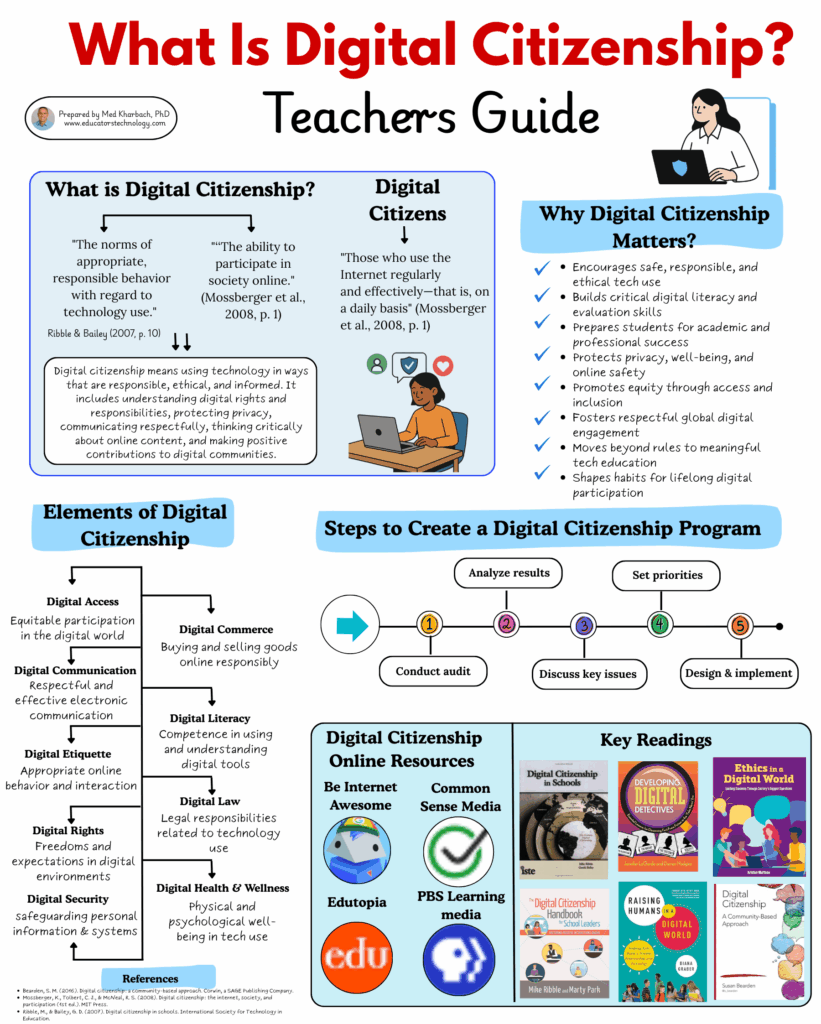AI now sits in the middle of how students search, write, share, and learn. That makes digital citizenship more than a one-week lesson. It is a set of habits and decisions students use every day. The visual in this post, “What Is Digital Citizenship? Teachers Guide,” summarizes the core ideas at a glance. Use the poster with the notes below to plan mini-lessons, anchor charts, and quick reflections.
What is digital citizenship
Scholars have defined digital citizenship in complementary ways. Ribble and Bailey (2007) call it “the norms of appropriate, responsible behavior with regard to technology use” (p. 10), while Mossberger, Tolbert, and McNeal (2008) describe it as “the ability to participate in society online” (p. 1).
And who counts as a digital citizen? Mossberger and colleagues (2008) point to “those who use the Internet regularly and effectively — that is, on a daily basis” (p. 1
Related: NotebookLM for Teachers and Researchers: A Complete Guide
Why digital citizenship matters now
Digital citizenship is more relevant than ever in an AI-powered world. Here are some key reasons it matters for today’s classrooms:
• encourages safe, responsible, and ethical tech use
• builds critical digital literacy and evaluation skills
• prepares students for academic and professional success
• protects privacy, well-being, and online safety
• promotes equity and inclusion through fair access
• supports respectful global engagement
• moves beyond rules to meaningful participation
• shapes habits for lifelong digital participation
Teaching Digital Citizenship: 9 Elements to Focus On
Digital citizenship covers more than just online rules, it’s a set of skills and habits students need to participate responsibly in today’s connected world. Here are the nine key elements to focus on when teaching it:
- Digital access
Equitable participation in the digital world. Plan for device access, read-alouds, captions, and low-bandwidth options. - Digital communication
Respectful, effective electronic communication. Model tone, audience awareness, and reply discipline in email and chat. - Digital etiquette
Appropriate online behavior and interaction. Practice short scenarios: what to post, what to keep private, how to disagree. - Digital rights
Freedoms and expectations in digital spaces. Discuss consent, terms of service, and students’ rights to their work. - Digital security
Safeguarding personal information and systems. Teach password managers, updates, and phishing recognition. - Digital commerce
Buying and selling online responsibly. Compare reputable vendors, refund policies, and dark-pattern warnings. - Digital literacy
Competence in using and understanding digital tools. Evaluate sources, trace claims, and check provenance of media. - Digital law
Legal responsibilities in tech use. Cover plagiarism, copyright, Creative Commons, and citation basics. - Digital health and wellness
Physical and psychological well-being in tech use. Build routines for breaks, ergonomics, and healthy social media habits.
How AI fits into each element
• Access: provide AI options that support learners who need translation, text-to-speech, or reading support.
• Communication: draft with AI, then edit for tone and clarity; compare human and AI phrasing choices.
• Etiquette: practice prompts that decline unsafe requests and rewrite toxic comments into constructive feedback.
• Rights: discuss data collection and model “privacy first” settings in AI tools.
• Security: show how to spot AI-generated phishing and deepfakes.
• Commerce: analyze subscription models, free trials, and hidden costs of AI platforms.
• Literacy: verify AI outputs with lateral reading; require citation of prompts and tools used.
• Law: explain fair use, licensing of AI images, and when permission is required.
• Health and wellness: set screen-time boundaries; reflect on AI’s impact on motivation and identity.
Steps to start a digital citizenship program
Starting a digital citizenship program can feel daunting, but it doesn’t have to be complicated. Here are some practical steps to help you plan, prioritize, and bring digital citizenship lessons into your classroom with confidence:
- Conduct a quick audit
Survey students’ tech habits and pain points. Collect a few real examples from your context. - Analyze results
Group needs by the nine elements. Identify three priority skills for this term. - Discuss key issues
Use short case studies: a suspicious link, a viral rumor, or an AI-written paragraph with errors. - Set priorities
Pick one routine per week, such as source checks on Mondays or privacy settings on Fridays. - Design and implement
Embed micro-lessons inside existing units. Make reflection part of the grade: what AI did you use, what did you change, why.
Classroom moves you can try tomorrow
Once students know the basics of digital citizenship, it’s time to put those skills into action. Here are some quick, high-impact classroom activities you can try to help them practice judgment, critical thinking, and ethical decision-making in real contexts:
- AI-assisted writing, human-led revision
Students generate a draft paragraph with an AI tool, then highlight every edit they made and explain the reason. - Credibility ladder
Give three sources on the same topic, including an AI summary. Students rank credibility and justify choices. - Privacy checklist
Students review one app’s settings, identify data shared by default, and write two concrete changes to protect themselves. - Deepfake spotter
Show two short videos, one authentic and one synthetic. Students list signals, check the source, and decide with evidence.
Online resources to bookmark
Suggested key readings for staff study
- Digital Citizenship in Schools (Mike Ribble)
- Ethics in a Digital World (Kristin Brynteson)
- Digital Citizenship: A Community-Based Approach (Jason Ohler)
- Developing Digital Detectives (Jennifer LaGarde & Darren Hudgins)
- Raising Humans in a Digital World (Diana Graber)
- The Digital Citizenship Handbook for School Leaders (Mike Ribble & Marty Park)

References
- Bearden, S. M. (2016). Digital citizenship : a community-based approach. Corwin, a SAGE Publishing Company.
- Mossberger, K., Tolbert, C. J., & McNeal, R. S. (2008). Digital citizenship : the internet, society, and participation (1st ed.). MIT Press.
- Ribble, M., & Bailey, G. D. (2007). Digital citizenship in schools. International Society for Technology in Education.
The post Digital Citizenship In The Age Of AI: A Practical Guide For Teachers appeared first on Educators Technology.







